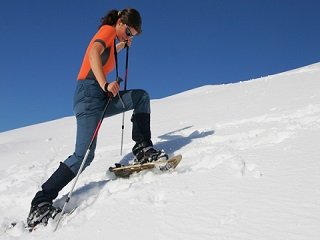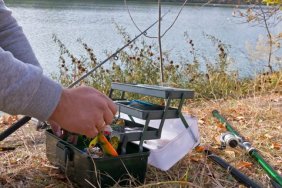 If you’ve been thinking about testing the frozen waters of snowshoeing, I hope that this month’s mini-guide to the activity has been illuminating. Today marks Part Two of the Technique leg of January’s Snowshoeing Guide, in which we’ll take a look at a few more tips on how to properly snowshoe.
If you’ve been thinking about testing the frozen waters of snowshoeing, I hope that this month’s mini-guide to the activity has been illuminating. Today marks Part Two of the Technique leg of January’s Snowshoeing Guide, in which we’ll take a look at a few more tips on how to properly snowshoe.
First up today is running in snowshoes. Contrary to the beliefs of many, it is, in fact, possible to run with snowshoes, but only really if you wear running-specific snowshoes, which possess spring-loaded bindings, a narrower frame for a more natural running stride, and lightweight construction. For the first few ventures into the snow, I suggest hitting flat, hard-packed trails for practice, at least until you get the technique down.
Yet another snowshoe technique to learn, practice, and master is known as traversing. Sometimes called "side-hilling," traversing is a common method of travel and can be used to avoid overly steep or difficult terrain. Keeping your balance is key here. To do it properly, push the uphill side of each snowshoe into the slope to create a shelf as you move along. Then, do your best to keep your weight on the uphill snowshoe. If possible, walk in the steps made by the person in front of you. If you’re using poles, extend the downhill pole and shorten the uphill pole until they're even.
Speaking of using poles, they come in handy on many snowshoeing outings. Not only do they provide improved balance, but they also help give your upper body a nice workout. Adjustable poles are better and very popular, because they can be shortened for uphill travel and lengthened for descending. When you use them, adjust the length so your arm is bent at a right angle. To use the straps properly, put your hand up through the strap from below. This allows you to rely on the straps alone at times to give your hands a brief rest.
It may not happen often, but people do occasionally fall down when snowshoeing. More often than not, falling occurs during descents. Should you start to fall, though, try to lie back or on your side. Once down, to get back up, take your pole straps off and move your poles and hands so they are sideways to the hill. Next, roll your body to get your knees underneath you and pointed towards the slope, then use your poles as a brace to help you stand up.
The techniques outlined in this segment of my Snowshoeing Guide will help you enjoy the activity that much more, not to mention stay safer on the trail. I hope the series has been a big help thus far, and urge you all to stop by for the last portion, where we’ll explore ways to stay safe while snowshoeing.








